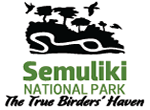[vc_row][vc_column width=”2/3″][vc_column_text]Semuliki National Park offers guided forest walks through what is widely recognised as Uganda’s only actual lowland tropical rainforest.
This ecosystem is an eastern extension of the Congo Basin’s Ituri Forest, marked by high humidity, flat topography, and semi-deciduous canopy cover.
The forest supports significant biomass, hosting over 336 tree species, many of which are endemic to the Albertine Rift.
Visitors access the forest primarily via three UWA-managed trails: Kirumia Trail, Red Monkey Trail, and Sempaya Nature Trail. Each is assigned based on distance, ecological focus, and time availability.
The Kirumia Trail is the longest and most ecologically rewarding. It extends 13 kilometers from the park’s headquarters to the Semuliki River. The route traverses swamp margins, mid-canopy zones, and tall grass clearings. This trail is recommended for birders and primate researchers. A complete walk requires 7 to 8 hours, with a guide-to-visitor ratio of 1:6.
The Red Monkey Trail, roughly 5 kilometers in length, follows the eastern park boundary towards the Semuliki River. The trail is named for the De Brazza’s monkey, a species occasionally sighted along this route. Walkers pass through thick ironwood stands and small seasonal wetlands. The whole round trip is achievable in under 3 hours.
The Sempaya Nature Trail offers the shortest experience. It connects directly to the hot springs area, covering a circular route of about 2.5 kilometers. This option includes canopy views, palm thickets, and marked birdwatching points. It is suitable for visitors with limited time or mobility.
Forest walks expose visitors to over 53 mammal species, including forest buffalo, blue duiker, and multiple primate types. Common primates include the black-and-white colobus, grey-cheeked mangabey, and red-tailed monkey.
Observations depend on the time of day and guide experience. Early morning departures yield higher primate activity.
Flora encountered along these trails includes Ficus mucuso, Pseudospondias microcarpa, and ground ferns such as Nephrolepis biserrata.
Insect diversity is high, with occasional army ant activity visible along drier segments of the Kirumia trail. Butterflies such as the Goliathus regius and Euphaedra medon are regularly recorded, especially near water patches.
UWA provides ranger guides for all walks. Visitors are required to carry water, wear long trousers, and use enclosed footwear. During wet months, trail flooding is common, particularly in May and October. Trekkers should expect slippery conditions and intermittent mosquito presence. The park recommends starting all walks before 10:00 hours to avoid afternoon rain or early dusk.
The forest walk is not restricted to wildlife observation. Many researchers use the trails for phenology tracking, dung counts, and soil moisture monitoring. Photography is permitted but often limited by low light and canopy obstruction. Macro lenses yield better results than telephoto equipment under these conditions.
This activity remains essential for understanding the Congo biome’s eastward transition into Uganda. It represents a rare chance to study or observe Central African rainforest ecology within a stable and secure park management framework.[/vc_column_text][/vc_column][vc_column width=”1/3″][vc_widget_sidebar sidebar_id=”shop-widget”][/vc_column][/vc_row]
